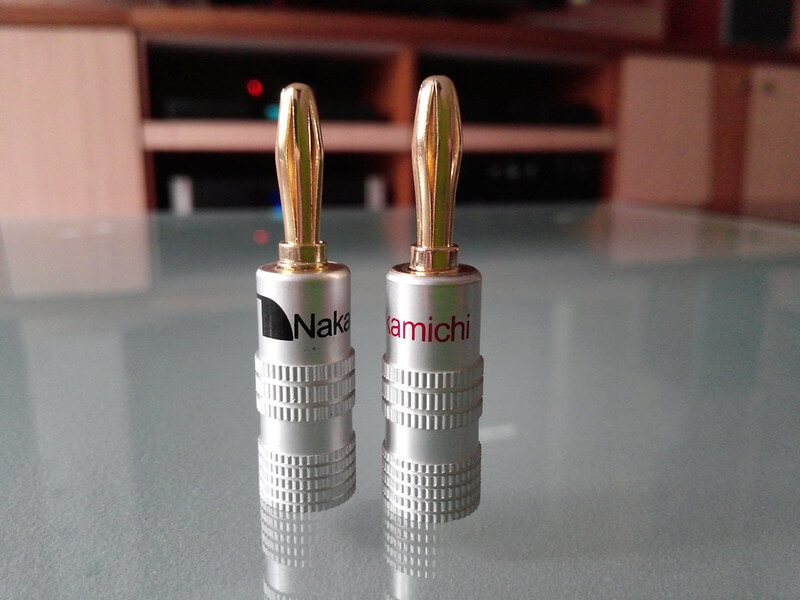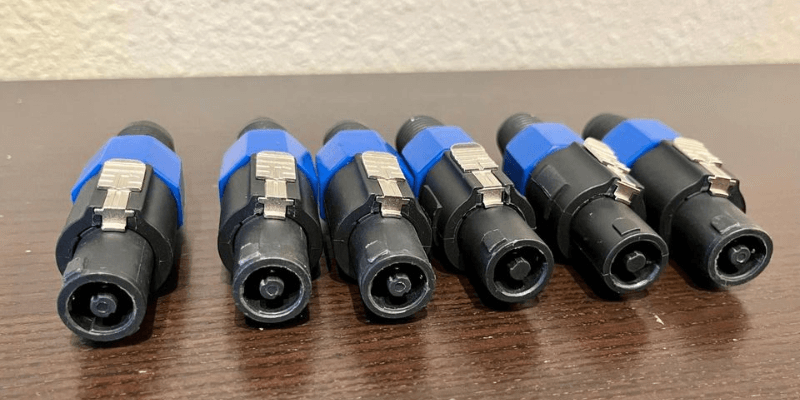Speaker connectors transfer audio data from your receiver, amp, or playback device to your speakers. You’ll come across various speaker connectors when setting up your sound system. Apart from choosing the right speaker cable, the correct type of speaker connector also matters. In this post, I’ll show you the different speaker connectors you can choose from.
1. RCA Connectors
This is one of the most common types of speaker connectors that can be used to connect speakers to an amplifier, receiver, and other audio gear. This connector is called a phono connector and is usually red and white for right and left audio channels, respectively. If not color-coded, the plugs or jacks are marked with an R and L, indicating the audio channel being carried.

RCA plugs are the male connectors with a metal connector at the end. At the same time, RCA sockets are the female connector usually found on the device being plugged in.
RCA connection only supports analog audio but can also be used for single-channel mono audio. Although it is still offered for connecting different audio equipment to speakers, other types of connections, such as optical digital audio, coaxial digital audio, and HDMI ports, offer better ways of sending audio between devices.
2. Banana Plugs
A banana plug is a connector used for connecting speaker wires to a binding post terminal or banana socket. In Europe, banana plugs can also be called 4mm connectors, but not all can connect with a 4mm socket.

Nakamichi Banana Plugs
Banana plugs have cylindrical plugs with sprung metal leaves that bulge outward. The metal leaves give the plug a strong connectivity option and also prevent it from falling out or disconnecting. To use a banana plug, you’ll need to solder, crimp, or screw the speaker wires onto the plug.
There are also dual-banana plugs that have molded housing of both positive and negative banana connectors spaced apart. They are easier to connect compared to a single banana plug.
3. Speaker Pins
A speaker pin is like a banana plug but smaller. Speaker pins lack the spring mechanism of banana plugs, which makes them more likely to fall out. However, they can be secure and held up when securely connected to the binding posts.
When comparing speaker pins to using a bare wire, most people prefer using bare wires because it gives a better connection. However, with bare wires, you’ll have to worry about the strands unraveling or oxidation. Given that, pins are still a better connector when working with speakers.
4. Binding Post
This is usually mounted on the chassis and allows connections from bare wires, banana plugs, pin connectors, and spade plugs. This option is better than the screw terminal because it is better and more secure. You can also use different types of connectors. Most speakers nowadays use binding connectors.

Binding Posts on Paradigm Speakers
5. Spade Connectors
These are usually U-shaped or forked-shaped and also work with binding posts. The spade connectors are inserted between the binding post and secured by tightening the binding post’s cap. Once tightened down, they maintain contact with the terminal’s base.

Spade Speaker Connectors
6. Speakon Connectors
If you’re looking to connect high-voltage audio equipment, a Speakon connector is what you’ll use. A Speakon connector was invented by Neutrik and worked to connect amplifiers to loudspeakers. The Speakon connector is popular with recording and pro equipment. However, they are also used for speaker-level connections between powered subwoofers and integrated amplifiers, stereo receivers, or power amps.

Speakon Connectors
Apart from handling more power, connectors have a twist and lock mechanism and non-shorting contact that protects against accidental disconnection, which can harm your equipment.
Speakon connectors are available in 2, 4, and 8 pole versions. 8-pole is more powerful than both 2 and 4-pole variants.
7. 1/4-Inch Plug
This is also called a 6.3mm phone connector because of its long history of usage in manual telephone switchboards. The 1/4-inch audio connector has long been used for pro audio connections.
It is also known as a TRS connector because of the three contact points: tip, ring, and sleeve. Two conductors, or TS phone connectors, were commonly used for connecting speakers. However, the speaker connector has replaced the TS connector in recent years.